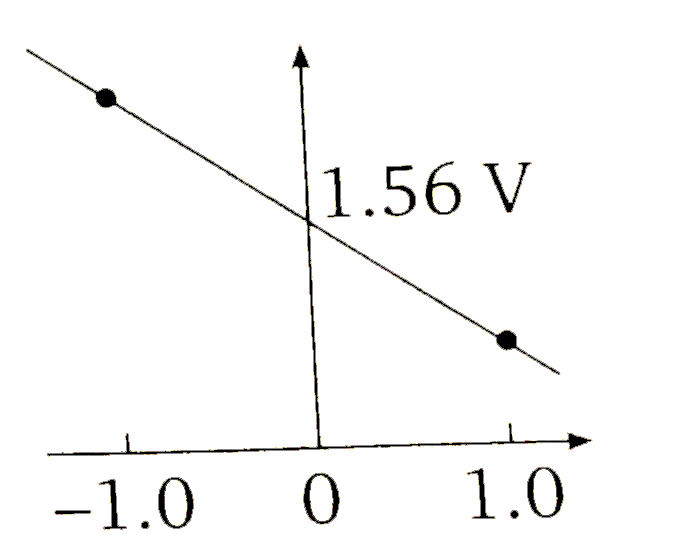Zn(s)+Cl2(1atm)→Zn2++2Cl−. Eocell of the cell is 2.12 V. To increase E
[Zn2+] should be increased
[Zn2+] should be decreased
[Cl−] should be decreased
PCl2 should be decreased
The correct Answer is:B, C
To solve the problem of how to increase the standard cell potential E∘cell for the reaction:
Zn(s)+Cl2(g)→Zn2++2Cl−
with a given E∘cell of 2.12 V, we can follow these steps:
Step 1: Understand the Nernst Equation
The Nernst equation relates the standard cell potential to the concentrations of the reactants and products:
Ecell=E∘cell−RTnFlnQ
where:
- Ecell is the cell potential under non-standard conditions.
- E∘cell is the standard cell potential (2.12 V in this case).
- R is the universal gas constant (8.314 J/(mol·K)).
- T is the temperature in Kelvin.
- n is the number of moles of electrons transferred in the reaction.
- F is Faraday's constant (96485 C/mol).
- Q is the reaction quotient.
Step 2: Determine the Reaction Quotient Q
For the given reaction, the reaction quotient Q is defined as:
Q=(Zn2+)PCl2
where:
- (Zn2+) is the concentration of zinc ions.
- PCl2 is the partial pressure of chlorine gas.
Step 3: Analyze How to Increase Ecell
To increase Ecell, we need to decrease the value of Q. This can be achieved by:
1. Increasing the concentration of the reactants (in this case, decreasing (Zn2+)).
2. Decreasing the concentration of the products (in this case, decreasing PCl2).
Step 4: Conclusion
To increase Ecell, we can:
- Decrease the concentration of Zn2+.
- Decrease the partial pressure of Cl2.
Thus, the most effective way to increase Ecell is to decrease the concentration of Zn2+ or decrease the partial pressure of Cl2.
The Nernst equation relates the standard cell potential to the concentrations of the reactants and products:
- Ecell is the cell potential under non-standard conditions.
- E∘cell is the standard cell potential (2.12 V in this case).
- R is the universal gas constant (8.314 J/(mol·K)).
- T is the temperature in Kelvin.
- n is the number of moles of electrons transferred in the reaction.
- F is Faraday's constant (96485 C/mol).
- Q is the reaction quotient.
For the given reaction, the reaction quotient Q is defined as:
- (Zn2+) is the concentration of zinc ions.
- PCl2 is the partial pressure of chlorine gas.
To increase Ecell, we need to decrease the value of Q. This can be achieved by:
2. Decreasing the concentration of the products (in this case, decreasing PCl2).
To increase Ecell, we can:
- Decrease the concentration of Zn2+.
- Decrease the partial pressure of Cl2.
Similar Questions
Knowledge Check
Zn(s)+Cl2(1atm)→Zn2++2Cl−,E∘Cellofthecellis2.12v.To∈creaseE
A[Zn2+] should be increasedB[Zn2+] should be decreasedC[Cl−] should be increasedDPCl2 should be decreasedThe reaction Cu2+(aq)+2Clc−(aq)→Cu(s)+Cl2(g) has Ec−.cell=−1.03V. This reaction
ACan be made to produce electricity in voltaic cellBCan be made to occur in an electrolytic cellCCan occur in acidic medium onlyDCan occur in basic medium onlyWhich graph correctly correlates Ecell as a function of concentration for the cell
Zn(s)+2Ag+(aq)→Zn2+(aq)+2Ag(s),E∘cell=1.56V
y-axis: Ecell, X-axis: log10[Zn2+][Ag+]2A B
B C
C D
D
Given that (at T = 298 K)
Cu(s)∣∣Cu2+(1.0M)∣∣∣∣Ag+(1.0M)∣∣Ag(s)E∘cell=0.46V
Zn(s)∣∣Zn2+(1.0M)∣∣∣∣Cu2+(1.0M)∣∣Cu(s)E∘cell=1.10V
Then Ecell for,
Zn∣∣Zn2+(0.1M)∣∣∣∣Ag+(1.0M)∣∣Ag at 298 K will be:
View SolutionFor the cell given, below
Zn∣∣Zn2∣∣∣∣Cu2+∣∣Cu,(Ecell−E∘cell) is -0.12 V. it will be when
View SolutionConsider the following reaction,
Zn(s)+Cu2+(0.1M)→Zn2+(1M)+Cu(s) above reaction, taking place in a cell, E∘cell is 1.10V.Ecell for the cell will be (2.303RTF=0.0591)
View SolutionThe overall reaction electrochemical cell at 298K.
Ag(s)|AgI(s)|I−(aq)∣∣∣∣Cl−(aq)∣∣Hg2Cl2∣∣Hg(l)∣Pt(s)
[Given: E∘Cl−|Hg2Cl2|Hg=0.26V.E∘Ag+∣Ag=0.8V.
Ksp(Agl)=10−16 and 2.303RTF=0.06]
E∘cell of the above cell is:
View SolutionThe reaction Cu2+(aq)+2Clc−(aq)→Cu(s)+Cl2(g) has Ec−.cell=−1.03V. This reaction
View Solution

